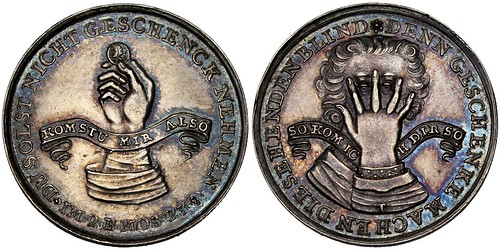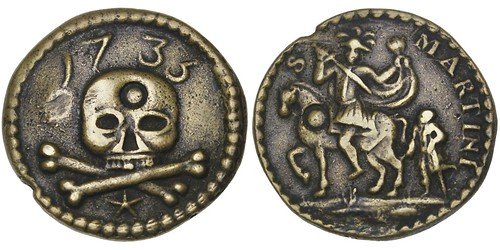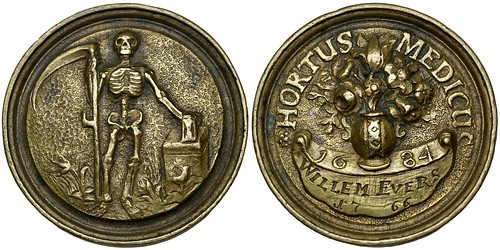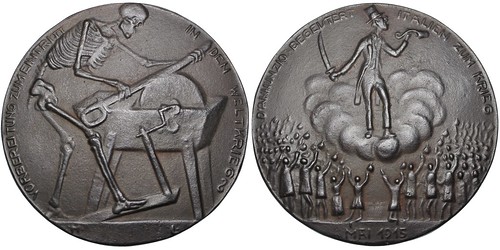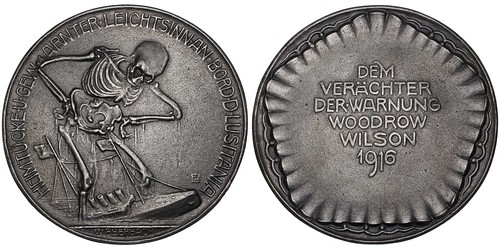
PREV ARTICLE
NEXT ARTICLE
FULL ISSUE
PREV FULL ISSUE
NUMISMAGRAM MEDAL SELECTIONS: OCTOBER 22, 2023Numismagram's Jeremy Bostwick forwarded these five fascinating tokens and medals from his most recent upload of new material to his site. This particular group is very seasonally appropriate, and features numismatic nightmares with rather haunting iconography. For all of the new items, please visit https://www.numismagram.com/inventory. -Editor 102468 | GERMANY. Hamburg. Satirical silver Medal. Issued circa 1708 or slightly thereafter. The supposed corruption of the imperial commission by the Jewish community (23mm, 4.64 g, 6h). By an uncertain medallist, marked "T." DU SOLST NICHT GESCHENCK NEHMEN (thou shalt take no gift...), hand putting forth a coin; across the middle, banner reading KOMSTU MIR ALSO (if you'll scratch my back...) // DENN GESCHENKE MACHEN DIE SEHENDEN BLIND (...for a gift blindeth them that have sight, and perverteth the words of the righteous, –adapted from Exodus 23:8 [2nd Book of Moses]), bust facing slightly right, with hand nearly covering face, though with eyes peering through; t on sleeve; across the middle, banner reading SO KOMME ICH DIR SO (...I'll scratch yours). [The underlined legends are meant to be read as a complete message, while the non-underlined legends are meant to be a separate complete message.] Edge: Reeded. Cf. GPH 1220-1 (different medallist); Brettauer 4796; Fieweger Coll. 345; cf. Vogel Coll. 8739 (gold). PCGS MS-62. Most attractively toned, with some cobalt and violet notes around the devices, and great brilliance remaining. Undoubtedly one of the more alluring examples of the type that one can hope to encounter. Compare to a similar (though highly inferior) example (PCGS AU-53) from a different medalist (Wermuth) that realized a total of $660 in the Stack's Bowers 2021 NYINC auction, lot 23546. $985. The city of Hamburg had a festering issue between its Senate and Citizens' Council in the late 17th century, with its local Jewish population a chief concern. Though a Sephardic Jewish population had much more long-standing roots in the city, the Ashkenazi population was, in contrast, much more recent and without actual legal status regarding its ability to reside there. The Citizens' Council—dominated by orthodox Protestants—along with the Lutheran clergy sought to block any concessions by the Senate to the Jewish populations, with the issue eventually escalating much higher within the hierarchy of the Holy Roman Empire. Emperor Joseph I appointed an imperial commission, led by Damian Hugo Philipp von Schönborn-Buchheim, to settle the dispute between the Senate and Citizens' Council in Hamburg. Ultimately, the commission redefined the legal relationships of the Sephardic and Ashkenazi Jewish populations in Hamburg, with the regulations becoming part of the new Hamburg constitution in 1712. It is quite likely that this satirical medal, along with the various others that share a common design and message, were meant to convey the idea that the Jewish citizenry had bribed the commission for recognition of their status, furthering an antisemitic viewpoint among the largely Protestant populace. Given the contemporary works of medallists like Christian Wermuth (who also contributed to this specific "series"), and his satirical issues like the "corn Jew," the concept of antisemitic medals would be completely within the context of the period, and seemingly a likely cause that would generate such a concerted medallic effort among numerous workshops.
To read the complete item description, see:
102001 | NETHERLANDS. Maastricht. St. Martin cast brass Funeral Token (Begrafenisloodje). Dated 1733. Receipt for prepaid funeral expenses (32mm, 13.13 g, 5h). Skull and crossbones; star below // S MARTINI, Saint Martin riding horse left, head right, giving his cloak to a beggar to right. Minard 357. PCGS EF-45. Yellow-brown surfaces, with lighter hues on the higher points; cancellation punch (as intended) on each side. Rare and interesting. The finer of just three seen in the PCGS census, and by far much more attractive and detailed than the other two. $1,895. Begrafenisloodje served multiple roles in the Low Countries during the 16th-19th centuries, acting as payment for gravediggers, pallbearers, or other funerary expenses, or acting as a commemorative for the funeral of the deceased—either to those attending the ceremonies or to the respective church in remembrance of the departed. Where they were utilized to indicate payment, a punch was generally placed upon one or both sides to act as a form of "cancellation" for the services rendered and payment received.
To read the complete item description, see:
102402 | NETHERLANDS. Amsterdam. Surgeon's Guild cast brass Toegangspenning (Admission Token). Engraved 1766 for Willem Evers, for the passing of the surgeon's exam/admission to the medicinal garden (42mm, 30.41 g, 12h). Skeleton (Grim Reaper) standing facing, holding scythe and resting hand upon hourglass on base to right; flowers at feet // HORTUS MEDICUS (medicinal garden), vase with various flowers set upon ornate base engraved "WILLEM EVERS / 17 66" and bearing the date 16-84. Edge: Plain. Brettauer 5198. Extremely Fine. Charming olive-brown surfaces, with a few spots of green on the reverse. A very rare and interesting medicina in nummis type. Compare to a similar example (though unengraved) that realized a total of $2,640 in the Stack's Bowers October 2021 CCO (lot 72539). $1,965. The obverse of this type—featuring a figure of Death along with an hourglass—is an allusion to the transient nature of life and, as such, a memento mori. It was used in Amsterdam as a token of one's membership into the guild of surgeons. Meanwhile, the reverse refers to the city's medicinal garden—the so-called hortus medicus—which housed various flora that could be used medicinally. Following the fallout of the plagues that had gripped Europe, along with portions of the rest of the world, the understanding and cultivation of plant-based remedies began to take form, with this garden serving in that role. The bearer of such a token would also have access to these grounds to make use of the plants grown.
To read the complete item description, see:
102327 | GERMANY & ITALY. Italy's Wavering Alliances cast iron Medal. Issued 1915 (73mm, 89.32 g, 12h). By H. Lindl. VORBEREITUNG ZUM EINTRITT IN DEN WELTKREIG, skeleton standing right, sharpening saber upon whetstone // D'ANNUNZIO BEGEISTERT ITALIEN ZUM KRIEG, D'Annuzio, in top hat and tails, standing right upon clouds, holding saber and speaking to the masses acclaiming below. Edge: Minor casting flaw as made in one spot, otherwise plain. Klose –; The Art of Devastation –; Frankenhuis 1508. PCGS MS-62. Charcoal gray surfaces, with a great matte nature. A very rare and haunting World War I-related satirical issue, and the only such example of the type in the PCGS census. A great analog to Eberbach's "Totentanz" series, issued contemporaneously and in a similar size, but far less encountered in the market. $1,495. Following five years living abroad in France, the famed Italian poet, Gabrielle D'Annunzio, returned to Italy in the spring of 1915, whereupon he began urging his homeland to join the cause not with the Central Powers, as Italy had fought, but with the Allied Powers. D'Annunzio's passions spread, even causing riots, with Antonio Salandra, the Italian Prime Minister, leading Italy back into the war with her former enemy.
To read the complete item description, see:
102331 | GERMANY, GREAT BRITAIN & UNITED STATES. Satirical cast iron Medal. Issued 1916. Totentanz (Dance of Death) series: The Sinking of the RMS Lusitania (69mm, 69.03 g, 12h). By W. Eberbach. HEIMTÜCKE • U • GEWARNTER • LEICHTSINN • AN • BORD • D • LUSITANIA (malice and forewarned recklessness on board the Lusitania), Death (as a skeleton) standing over the sinking Lusitania in taunting stance // DEM / VERÄCHTER / DER • WARNUNG / WOODROW / WILSON / 1916 (to the despiser of warnings, Woodrow Wilson) in six lines within scalloped polylobe. Edge: Some filing marks as made, otherwise plain. The Art of Devastation, p. 264, 60; Frankenhuis 1497. PCGS MS-62. Light charcoal gray surfaces, with a somewhat matte nature. Compare to a similar raw example (though with noted graffito in the obverse field) that realized a total of $1,920 in the Stack's Bowers 2021 ANA auction (lot 40405). $1,795. Similar to the satirical medallic issues of Karl Goetz, Walther Eberbach was inspired by the events of World War I to create a series of rather morbid medals to propagandize the German war effort. The theme upon which he decided to focus was the Totentanz, or "Dance of Death." This series of issues, a divergence from the ephemeral topic of vanitas, portrayed Death as a skeleton, quite gleefully taking joy in the demise of his enemies—the allied powers—rather than a subtle reflection upon life and death. This frank morbidity is expressed by Eberbach himself in a letter to Julius Menadier, in which he writes "...I want whoever holds the pieces in their hands years later to be overcome by the shudder grimness." It's safe to say that, in this desire, Eberbach was astoundingly successful. This haunting piece recounts the sinking of the Lusitania from the German perspective, denying their responsibility and instead placing it upon U.S. president Woodrow Wilson. The contents on board (referenced on the obverse) are an allusion to the munitions which the Lusitania was secretly carrying—a violation of the warnings issued in February 1915.
To read the complete item description, see:
Wayne Homren, Editor The Numismatic Bibliomania Society is a non-profit organization promoting numismatic literature. See our web site at coinbooks.org. To submit items for publication in The E-Sylum, write to the Editor at this address: whomren@gmail.com To subscribe go to: https://my.binhost.com/lists/listinfo/esylum All Rights Reserved. NBS Home Page Contact the NBS webmaster 
|
